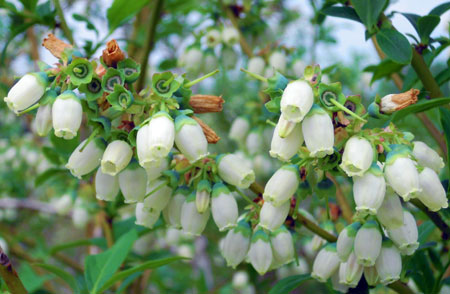Southwest Michigan fruit regional report – May 21, 2013
Warm, dry weather has fruit crops moving rapidly. Blueberries are blooming and grape bloom approaches.
Weather
Last week was warm and dry with highs near 80 degrees Fahrenheit all week. Sunday (May 19) was much warmer – near 90 F. Low temperatures rose from lows near 29 and 30 F on Monday, May 13, to the 60s late in the week. No rain fell last week and soils were drying out rapidly as plants suck the water out of the topsoil. Storms moved through the region Tuesday morning (May 21), dropping one- to two-thirds of an inch of rain.
Cooler, unsettled weather with a chance of thundershowers is forecast for the next few days. Check your local weather station and conditions at Enviro-weather. Our growing degree day (GDD) totals are less than a week behind normal.
Southwest Michigan GDD Summary from January 1 to May 20, 2013
|
Station |
GDD 42 F |
GDD 45 F |
GDD 50 F |
|
Benton Harbor (SWMREC) |
555 |
454 |
314 |
|
Fennville (TNRC) |
490 |
395 |
267 |
|
Average for the region |
553 |
452 |
313 |
Tree fruit
Tree fruit across southwest Michigan look very good. Low temperatures on Monday, May 13, caused light damage to apples and peaches. Damage was most severe in low areas where the cold air accumulated and temperatures dropped below 28F. Rains will be favorable for many diseases including apple scab, fire blight, pear scab, cherry leaf spot and brown rot of stone fruit. Insect activity is increasing rapidly with the warm weather. Plum curculio activity is up and egglaying can begin at any time. Oriental fruit moth trap catch numbers were high numbers last week. Pheromone disruption products should already be out to suppress mating of this insect.
Apricot fruit are out of the shuck with a good crop potential. The largest fruit are about 18 millimeters in diameter.
Peach fruit are coming out of the shuck. Significant freeze damage from May 13 was reported in some low areas, but generally fruit set looks excellent. Nectarines should be examined for signs of tiny western flower thrips crawling and flying about the developing fruit.
Oriental fruit moth biofix was set for May 9, but some areas should reset to May 14 due to the freeze. Trap catches were strong across the region on May 17. Control for oriental fruit moth is recommended at approximately 100 to 150 GDD base 45 F for products with ovicidal activity, or 170 to 195 GDD (10 to 15 percent of egg hatch) for products (organophosphates, carbamates or pyrethroids) with direct contact insecticide effects against hatched larvae from the biofix date.
Developing fruit become directly susceptible to bacterial spot and rusty spot (powdery mildew) once the fruit emerges from the shuck until approximately pit hardening. Peach leaf curl symptoms started appearing in the area late last week.
In cherries, little damage was reported from the May 13 freeze. This was because the trees had good foliage and the fruit was protected from the cold by the shuck. Leaves are susceptible to cherry leaf spot infections. Only one cherry leaf spot infection period (May 9) had occurred up through May 18. The current wet period is already another infection. Exposed fruit is susceptible to plum curculio egglaying.
Sweet cherry fruit are 13 millimeters in diameter and plum curculio egglaying scars were found Monday (May 20). Growers should be protecting against plum curculio and cherry leaf spot.
Tart cherries are emerging from the shuck. The largest fruit are 10 to 12 millimeters. Two distinct sizes of fruit are visible. Growers should be protecting against plum curculio and cherry leaf spot.
Plums are 8 millimeters (Stanley) and 11 millimeters (Shiro) at the Southwest Michigan Research and Extension Station (SWMREC). Growers should be protecting against plum curculio and black knot. Black knot controls are needed until active shoot growth slows in early to mid-summer. Fruit emerging from the shuck is prone to direct damage by plum curculio and bacterial spot.
Apples are generally past petal fall. Apple fruit are 6 to 8 millimeters in diameter. Light to significant damage in the low sites or in the low areas in orchards has been reported across the region, but the overall crop potential looks good. Recent hot and cloudy weather have stressed developing fruit so that natural fruit thinning is expected to be heavy. This drop should be apparent by the end of the week. Many growers will still need to apply thinners soon. See the Michigan State University Extension article “Apple thinning pointers for 2013” for more information. The next thinning window will be towards the end of the week when temperatures begin to warm again.
With this rain, growers should protect against fireblight infection in orchards with open bloom. Rains on Tuesday morning (May 21) triggered a blossom blight infection. The infection potential (EIP) index for fire blight has been well over 300 for the blossom blight portion of the Maryblyt model on Enviro-weather. These are the final ingredients needed for a full fire blight infection period. The Maryblyt model also predicts that symptoms from the May 9 infection period should show up this week. Many growers applied Apogee at petal fall to reduce the spread of fire blight after infection.
Apple scab and powdery mildew are the other apples diseases of concern. The next rain is expected to cause the release of a relatively sizable number of scab ascospores. Symptoms from the May 9 infection period are expected any time now. Apples are also susceptible to plum curculio.
Overwintering obliquebanded leafroller larvae, approximately 0.5 inches length, have been seen feeding and webbing on shoot tips and flower clusters. Codling moth males have been caught in area orchards for the past two weeks. Numbers this past week were sufficient for some sites to set a biofix for May 18. Spray timing can be calculated from the codling moth model on Enviro-weather (Be sure to note the insecticide recommendations below the model.).
Pears are approximately 14 millimeters in diameter. Damage from the freeze has not been assessed, but an accurate assessment can be made in the next few weeks after the June drop. Pears were also subjected to a fire blight infection on May 9. Growers should consider the need for Apogee treatment to suppress shoot growth and reduce fire blight susceptibility. Growers should continue to protect against pear scab and scout for pear psylla activity.
Small Fruit
In grapes, warm temperatures have caused shoots to develop rapidly. ‘Concord’ and ‘Niagara’ have 8- to 16-inch shoots and elongating flower clusters at SWMREC. ‘Chardonnay’ has 5- to 10-inch shoots and ‘Cabernet franc’ has 6- to 12-inch shoots.
More grape berry moth adults were trapped this week, but numbers are still light. The first generation of grape berry moth overwinters as pupae in leaf litter around vineyards and emerges before bloom. We have not yet reached biofix for grape berry moth. Biofix is calculated as 50 percent bloom on 50 percent of flowers of wild grape (Vitis riparia). The black locust tree (Robinia pseudoacacia) is usually at early to full bloom at the same time wild grape is at the biofix stage for grape berry moth.

Black locust at early to full bloom is a good indicator plant for
wild grape bloom grape berry moth biofix stage.
Photo credit: Diane Brown, MSU Extension
Black locust grows at woods edge and is highly visible when in bloom. Its showy clusters of fragrant, white, pea-like flowers make a good reminder to check wild grapes.
Strong winds from the south should prompt growers to be on the watch for potato leafhoppers as they tend to blow in on storms. We found the first spots of phomopsis on ‘Cabernet franc’ on Monday. As we get closer to bloom, the importance of timely fungicide applications and good coverage increases if diseases are to be well-managed. Consult the 2013 Michigan Fruit Management Guide (E154) for recommended fungicides. Powdery mildew control may be needed now for problem areas or highly susceptible varieties, but can generally wait until bloom for ‘Concord’.
Blueberries are in bloom and suffered little damage from the freeze. Bloom is ending in early varieties such as ‘Bluetta’ and ‘Weymouth’. ‘Bluecrop’ is near full bloom. In other varieties such as ‘Jersey’, ‘Ruble’ and ‘Elliott’, bloom is well underway. Bloom in many varieties is heavy.

Bluecrop is near full bloom. Photo credit: Mark Longstroth, MSU Extension
The ground in some fields is white with shed petal tubes. Pollinated blueberry flowers quickly shed their petal tubes so that growers can assess pollination. Mummy berry shoot strike symptoms can be found, so fungicides to protect against mummy berry blossom infections need to be applied. Protectants are applied at early bloom and again at full bloom. Later bloom sprays should focus more on protecting green fruit using fungicides with a different mode of action (FRAC code).
Cherry and cranberry fruitworm are both flying (see “Fruitworms in blueberry control options”). The use of Intrepid is restricted in Allegan County. Allegan growers should use another material. Michigan State University Extension recommends growers avoid all pesticide sprays of blooming blueberry fields during the day when bees are foraging. Try to finish any pesticide sprays (even bee-safe materials) early in the morning, so bees are not actually sprayed.
Strawberries are blooming and early blooms have set fruit. Damaged flowers from the May 13 freeze are clearly visible. We will be watching for strawberry bud weevil (clipper) and tarnished plant bugs (see “Managing tarnished plant bug injury to strawberries”). Everbearing strawberries in the high tunnels suffered minor freeze damage, but still have many berries. Powdery mildew has shown up on several research strawberry cultivars that seemed sensitive last year. This disease has not appeared on the commercial cultivars.
Bramble flower buds are easily visible and bloom should begin when it warms back up. There was damage to early variety flowers buds from the May 13 freeze. Orange rust infected plants should be removed. Fungicides recommended for orange rust in the 2013 Michigan Fruit Management Guide (E154) will only prevent new infections.
Upcoming meetings
The next Monday fruit IPM meeting is on June 3 at Fruit Acres Farms at 5 p.m. There is no meeting on May 27 (Memorial Day). These weekly meetings are good for one RUP credit and will continue through the end of June.
The next Grape IPM meeting series is May 22, 6 to 8 p.m., at Cronenwett Farms, 70121 28th St., Lawton, MI 49065 (view map).
Weed Identification and Management for Vineyards workshops will take place June 6 (southwest Michigan) and June 7 (northwest Michigan). These half-day workshops will cover weed identification and management in grapes.



 Print
Print Email
Email